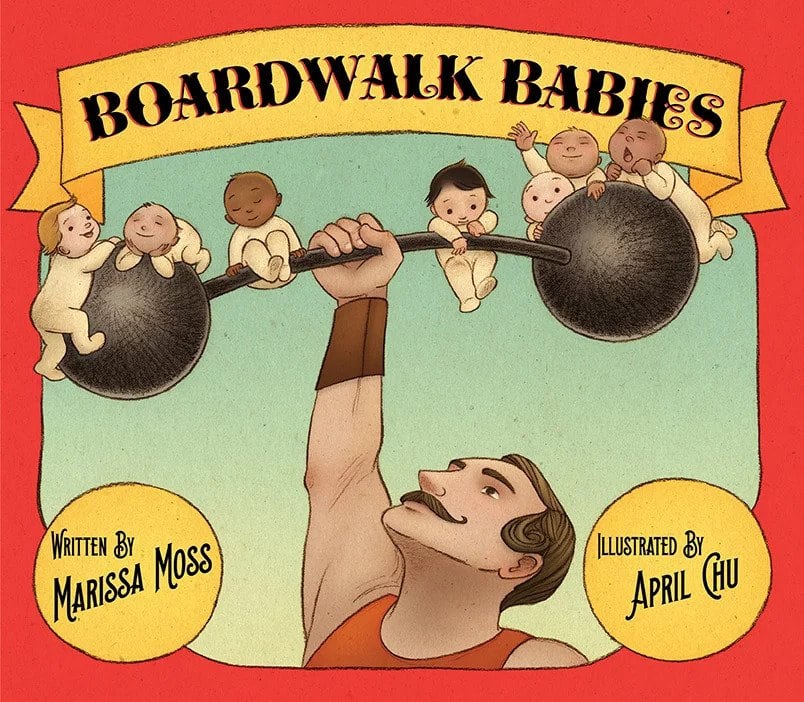
Boardwalk Babies
March 2021
Description
In the late 19th century, there wasn’t much hope for premature babies – until Dr. Couney developed the incubator. The device was so new and strange, hospitals rejected it. So Dr. Couney set up a sideshow at Coney Island, taking care of the tiniest newborns as part of a display to convince the public that incubators worked. Thousands of babies grew into healthy children as Boardwalk Babies, including Dr. Couney’s own premature daughter. Many of those babies came back as adults to thank the doctor for his miracle cures. Science meets magic show in this fascinating true story.
Reviews
“At the 1896 Great Industrial Exposition of Belin, Dr. Martin Couney demonstrated the use of incubators in saving the lives of premature babies. Soon afterward, he immigrated to America and, from 1903 to 1943, staffed and ran an infant-care facility on the boardwalk on Coney Island, complete with a barker to bring in viewers to see the babies in their incubators. Although the location was unconventional, Couney was serious about his mission to give these preemies the best possible care and to show that incubators provided the healthiest environment for them. Statistics backed up his belief, and, gradually, incubators became standard equipment in American hospitals. Moss, whose previous picture-book biographies include Kate Warne, Pinkerton Detective (2017) and Sky High: The True story of Maggie Gee (2009), tells a story grounded in facts and full of human interest. Who could have predicted that Couney’s own child, born prematurely, would begin life in one of Couney’s incuators? With curving lines and warm colors, the illustrations create a genial tone while transporting viewers to a bygone era. An intriguing picture book.” — Booklist Review Booklist Boardwalk Babies Review
Kids will be amazed to learn that a “Baby Incubator” exhibit opened at Coney Island in 1903, attracting huge crowds. Spectators flocked to ogle tiny newborns and the groundbreaking technology –the “warming boxes” themselves– designed to keep premature babies alive. Back then, medical wisdom held that tiny, fragile newborns couldn’t survive, and hospitals, skeptical of newfangled machines, wouldn’t use them. German-born Dr. Martin Couney believed otherwise. His own mentor in Paris had suggested using incubators for preemies, and Couney at first demonstrated the machines without babies at the Berlin Exposition of 1896. In order to help the public better understand that they really worked effectively, Couney then placed infants in them. This enhanced exhibit succeeded wildly, and the babies survived. In 1903, Couney established what became a permanent preemie hospital display, complete with incubators, on Coney Island’s boardwalk. The newborns received round-the-clock nursing care, with admission fees paying for food, treatment, equipment, and medical personnel; it closed in 1943. This smoothly written account of little-known events results in a heartwarming story that will help develop audience empathy. Appealing illustrations capture the period and ambiance nicely and depict winsome infants of different races and ethnicities. A thought-provoking telling of an unusual historical episode. (author’s note, select bibliography) (Informational picture book. 6-9) — Kirkus Reviews
Moss (the Amelia’s Notebook series) surveys the use of premature infants as sideshow entertainment in this informative overview of pioneering pediatric history, which occurred on the Coney Island boardwalk from 1903 to 1943. To convince a highly skeptical medical establishment of incubators’ lifesaving value, neonatal technology advocate Martin Couney ran the Baby Incubator exhibit each summer. Staffed by medical professionals-including Couney’s wife and, later, daughter (born prematurely)-the exhibit saved 6,500 babies: “It didn’t matter what religion they were, the color of their skin, or how poor the parents were. Families weren’t charged anything… entrance fees paid for everything.” Chu’s (In a Village by the Sea) realistic illustrations in muted hues set a gentle tone… this narrative nonfiction account will prove absorbing. Ages 8-9. (Mar.) — Publishers Weekly
Starred review from School Library Journal Gr 1-2 -In the late 19th century, hospitals didn’t know how to care for premature babies and believed they were “doomed to die.” However, one young doctor believed he had the answer. Dr. Martin Couney of Germany asked Empress Augusta Victoria to allow him to care for babies from her hospital in his newly invented baby incubators. Empress Victoria approved his request. Couney created a traveling showcase of the world’s tiniest babies, first in exhibition halls and world fairs, then finally settling into a permanent spot on Coney Island in 1903. Babies received the best care from a dedicated and trained nursing staff, paid for by the entrance fees to see the exhibit. Babies of all races, religions, and backgrounds were accepted. Couney generated as much publicity as he could. He hired carnival barkers to advertise the exhibit and emphasized the small size of the babies by dressing them in oversized clothes and bows. The public loved watching the tiny tots grow and thrive, but it was the hospitals that Couney hoped to convince-he wanted incubators in every hospital. Over the years, Couney saved 6,500 babies, many of whom came back to thank him when they grew up. Moss turns a little-known historical subject into a poignant and readable picture book. In particular, the direct and clear approach to explaining the needs and the care of premature babies is handled well. The soft illustrations and the heartwarming approach make this story beautiful and relevant to all families. VERDICT A moving must-have for every nonfiction collection. -Savannah Kitchens, Parnell Memorial Lib., Montevallo, AL
